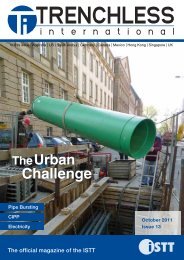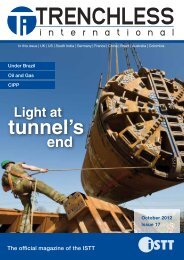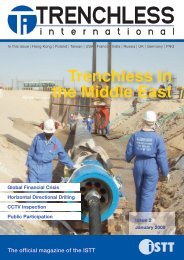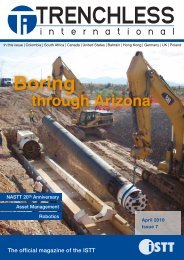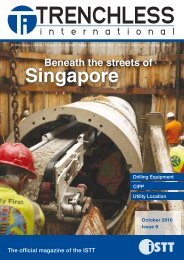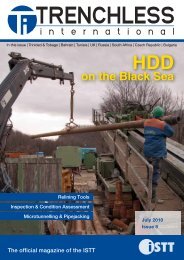North American Special - Trenchless International
North American Special - Trenchless International
North American Special - Trenchless International
You also want an ePaper? Increase the reach of your titles
YUMPU automatically turns print PDFs into web optimized ePapers that Google loves.
SPR technology<br />
SPR utilises steel-reinforced interlocking PVC profile strips sealed<br />
in place by a high-pressure grout. The installation equipment can be<br />
utilised via standard manhole access points without site excavation.<br />
Sekisui’s CPT SPR technology can also be installed in vertical<br />
applications such as wet wells, access shafts and other large diameter<br />
structures.<br />
SPR is a spiral winding technique which is particularly well suited<br />
to the renewal of very large diameter pipelines – up to 5 metres. In<br />
addition to standard circular profiles, egg-shaped and horseshoe<br />
profiles, any custom shapes can also be provided. The winding<br />
machine is specially adapted to each project, enabling it to cover<br />
a very wide range of applications. SPR technology is already being<br />
successfully deployed in Asia and the USA to renew large diameter<br />
pipelines.<br />
The SPR process is unique as it can provide a customised structural<br />
solution to aging pipelines. It can be engineered to correct hydraulic<br />
anomalies as well as restore the slope of the original pipe. The<br />
interlocking edges of the profile create an impermeable mechanical<br />
lock that can withstand strong deformational forces.<br />
SPR liners have been tested in accordance with industry standards<br />
and meet or exceed the standards for spiral wound PVC Profile Wall<br />
Liners ASTM F – 1697-02 and F 1741-02a. Furthermore the SPR PVC<br />
profile has a Manning’s coefficient of n = .010.<br />
PROJECTS<br />
April 2009 - <strong>Trenchless</strong> <strong>International</strong><br />
All wound up in Poland<br />
Szczecin, Poland is the first city in Europe to benefit from a new Japanese renewal technology, spiral<br />
pipe renewal (SPR).<br />
When the tender for a renewal project<br />
in Szczecin, Poland was first issued at the<br />
beginning of 2008, GRP short-pipe lining<br />
was specified. However, after some extensive<br />
research by the customer it was found<br />
that it would be very difficult to maintain the<br />
required water flow rates using the chosen<br />
technique. Severe deformation of the old<br />
pipe, which was not identified during the<br />
planning stage, meant that if a GRP shortpipe<br />
lining was used, the diameter of the<br />
renewed pipe would be much smaller,<br />
and so reduce the capacity of the new<br />
pipeline.<br />
Another challenge was posed by the fact<br />
that the pipeline being renewed in Szczecin<br />
was a main collector in the city centre,<br />
where it would be impossible to construct a<br />
dewatering system. Even though a large pit<br />
for the GRP lining had already been dug,<br />
at the last minute the customer decided<br />
– based on the new demands faced – to<br />
opt for the first ever European use of SPR<br />
technology.<br />
The masonry-lined combination sewer<br />
was built over a century ago. The condition<br />
of the sewer had deteriorated severely<br />
in recent years. As a result of continuous<br />
traffic and other external loads, longitudinal<br />
cracks had formed along the crown of the<br />
pipe, leading to increased deformation.<br />
Renewal had become a matter of urgency.<br />
There were also a large number of deposits<br />
and other obstacles protruding as much as<br />
50 cm into the pipe. Consequently, it was<br />
clear that thorough cleaning and jet-grouting<br />
work would have to be carried out prior<br />
to the renewal process. The SPR installation<br />
process can be divided into three key<br />
stages: the winding of the PVC profile, the<br />
construction of the bracing system and the<br />
grouting of the annulus<br />
Winding process<br />
The winding was executed starting from<br />
the manhole access shaft downstream to<br />
the next shaft. Based on the local conditions<br />
and the existing 18 metre long pit, the<br />
stretch of pipeline scheduled for renewal<br />
was divided into four segments. The winding<br />
machine installed the profile in the existing<br />
pipeline guided the profile and formed it<br />
into the desired shape, with an inner<br />
diameter of 2,240 x 1,600 mm.<br />
The winding machine<br />
moved one<br />
The SPR winding machine pulls the SPR profile into place and<br />
engages the dual locking mechanism.<br />
profile width forward on each rotation of the<br />
profile, locking the profile edges to form a<br />
water-tight pipe in the process.<br />
As soon as the machine’s forward<br />
momentum had taken it to the next shaft,<br />
the winding process was stopped and<br />
the profile separated. The team from the<br />
Polish construction company, together with<br />
the Japanese engineers, laid the<br />
winding machine and<br />
the profile reel to the<br />
next shaft, which<br />
then served as the<br />
new starting<br />
Bracing the shaft.<br />
point for the next installation phase and as<br />
the conduit through which the profile was<br />
again guided by the winding machine, as<br />
in the first phase.<br />
Bracing system<br />
In the next step, when the winding process<br />
was complete, the expert team constructed<br />
the bracing system. The braces were introduced<br />
through the shaft into the spiral<br />
wound pipe and carefully installed. The<br />
constructed cross-section of the bracing<br />
system prevents lifting of the new spiral<br />
wound pipe during subsequent grouting<br />
and prevents deformation.<br />
Grouting<br />
The grouting process for each renewal<br />
segment comprised injection of the grout<br />
into the annulus between the old pipe and<br />
the spiral wound PVC profile and curing of<br />
the grout. The team executed the grouting<br />
work in three stages. Then the braces<br />
were dismantled and installed in the next<br />
renewal segment. The pit area was grouted<br />
to a statically determined height above the<br />
spiral wound PVC profile.<br />
SPR technology in Poland.<br />
Below: SPR PVC profile is unreeled and fed<br />
into the winding machine.<br />
For further information contact Christopher Moritz at KMG LinerTec GmbH:<br />
christopher.moritz@sekisuicpt.com<br />
Summary<br />
All work was carried out by the team<br />
comprising workers from the local Polish<br />
agent of Sekisui CPT and Japanese technical<br />
specialists. The renewed sewer<br />
is beneath one of the main streets in<br />
Szczecin, and collects the rainwater and<br />
sewage from all the smaller surrounding<br />
systems. Work was interrupted several<br />
times due to flooding and above average<br />
rainfall, and lost time had to be made up<br />
for at night. However, since SPR can also<br />
be applied with drainage, the installation<br />
could be resumed without problem following<br />
the enforced breaks.<br />
Headed by Christopher Moritz, an<br />
expert team provides technical know-how<br />
and support covering all aspects of the<br />
new technology. “One of the key benefits<br />
of the SPR PVC profile from Sekisui is its<br />
environmental sustainability – including 60<br />
per cent less fossil fuel consumption, 30<br />
per cent less energy use and four times<br />
lower CO2 emissions in production.<br />
“That is one of the factors that will<br />
enable us to achieve our goal of delivering<br />
premium renewal solutions and becoming<br />
the market leader in the renewal of<br />
large-diameter pipelines in Europe,” said<br />
Mr Moritz.<br />
Despite the very difficult weather conditions,<br />
the European premiere of SPR<br />
technology was successfully completed<br />
within approximately two months.<br />
PROJECTS<br />
April 2009 - <strong>Trenchless</strong> <strong>International</strong><br />
26<br />
27






